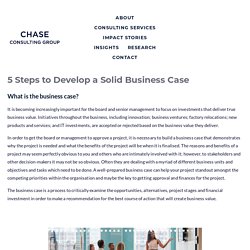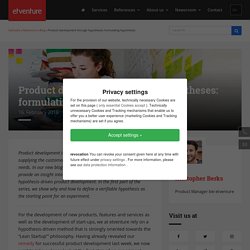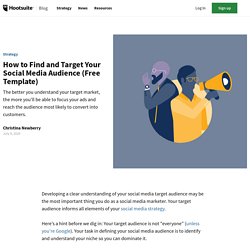

Five Steps to Develop a Solid Business Case — Chase Consulting Group: Innovation and Strategy Specialists. Why create a business case?

Preparing the business case enables you to take a disciplined approach to critically examine the opportunity, the alternatives, the project stages and the financial investment in order to make a recommendation for the best course of action to create the business value. When the time is taken to develop a solid business case, the investment proposal is much more informed. In turn, this will increase the benefits and value of the project and reduces the risks.
There is also a much greater likelihood of securing support to proceed with the investment. A business case is required when you need to: Types of business cases The required depth of analysis that is documented in support of your case will be based on the size and complexity of the investment decision. Customer Development with Steve Blank: Hypothesis Testing. In the startup community it can sometimes seem that buzzwords come from out of nowhere.

Not the case with “pivot”: Steve divulges that this is actually a term coined by his “best student ever” Eric Ries, when he noticed the cyclical nature of customer validation and customer discovery – stemming from his work developing lean startup methodology. So what is a pivot, exactly? A pivot is the action you take when you discover that your hypotheses don’t meet reality. It used to be that if a business wasn’t succeeding, executives would get fired. What we’ve come to realize in recent years is that if your business model doesn’t match what’s going on in the real world, it’s time to fire the model. A pivot is a substantive change to one or more of the business model components. A few examples of when you should pivot: Historically, founders were the only ones making pivots. Phase 1: State your hypotheses and draw the business model canvas. Phase 3: Test the solution. Phase 4: Verify your pivot. Product development through hypotheses: formulating hypotheses.
Product development is confronted with the constant challenge of supplying the customer with a product that exactly meets his needs.

In our new blog series, etventure’s product managers provide an insight into their work and approach. The focus is on hypothesis-driven product development. In the first part of the series, we show why and how to define a verifiable hypothesis as the starting point for an experiment. For the development of new products, features and services as well as the development of start-ups, we at etventure rely on a hypothesis-driven method that is strongly oriented towards the “Lean Startup”1 philosophy. Having already revealed our remedy for successful product development last week, we now want to take a closer look at the first step of an experiment – the formulation of the hypothesis. “Done is better than perfect.” – Sheryl Sandberg Where do hypotheses come from? How to calculate your total addressable market and make a great TAM slide for investors — For Entrepreneurs.
How to Define Your Target Market: A Guide to Audience Research. Developing a clear understanding of your social media target audience may be the most important thing you do as a social media marketer.

Your target audience informs all elements of your social media strategy. Here’s a hint before we dig in: Your target audience is not “everyone” (unless you’re Google). Your task in defining your social media audience is to identify and understand your niche so you can dominate it. Audience research will help you craft relevant content, messaging, and ads. All of this can lead to higher conversion rates and better social media ROI.
Are You Ready to Change Your Target Customer? Executive Summary Companies expanding into new markets often purchase a local player and convert it to their existing strategy, often changing the customer focus in the process.

This can be a costly mistake, as Australian DIY Chain Bunnings found to its detriment. Bunnings’ venture in the UK failed because its strategy required a radical shift in primary customers. Companies in similar positions should avoid acquiring businesses whose target customer is too different from its own, or have a clear plan for making careful choices about which customers to prioritize. Successful businesses know exactly who their target customers are. Take the highly successful Australian retail hardware chain Bunnings, which dominates its regional market, with 330 trading locations across Australia and New Zealand.
In 2016, Bunnings thought: if our formula works well in Australia, why not in the U.K. and Ireland? 16 ND036 C1 L2 18 Lesson Recap. 15 ND036 C1 L2 17 Business Case. 14 ND036 C1 L2 14 Evaluating A Hypothesis. 13 ND036 C1 L2 13 Creating A Hypothesis. 12 ND036 C1 L2 12 ROI. 11 ND036 C1 L2 11 Total Addressable Market Exercise Solution. 10 ND036 C1 L2 10 Total Addressable Market Exercise. 9 ND036 C1 L2 09 Total Addressable Market. 8 ND036 C1 L2 08 Target User Solution. 7 ND036 C1 L2 07 Exercise Target User. 6 ND036 C1 L2 06 Target User. 5 ND036 C1 L2 05 Industry Trends Solution. 4 ND036 C1 L2 04 Exercise Industry Trends. 3 ND036 C1 L2 03 Market Overview. 2 ND036 C1 L2 02 Finding The Right Problem To Solve. 12 Things about Product-Market Fit - Andreessen Horowitz. BOND - Internet Trends 2019.